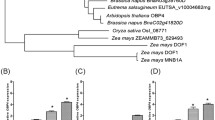Abstract
The petunia NAM and Arabidopsis ATAF1 and CUC2 genes define the conserved NAC domain. In petunia, loss-of-function nam mutants result in embryos that fail to elaborate shoot apical meristems (SAM), and nam seedlings do not develop shoots and leaves. We have isolated a NAC domain gene, AtNAM, from an Arabidopsis developing seed cDNA library. Expression of AtNAM mRNA is restricted primarily to the region of the embryo including the SAM. The AtNAM gene contains three exons and is located on Chromosome 1. In vivo assays in yeast demonstrate that AtNAM encodes a transcription factor and that the NAC domain includes a specific DNA binding domain (DBD). The AtNAM DBD is contained within a 60 amino acid region which potentially folds into a helix-turn-helix motif that specifically binds to the CaMV 35S promoter. The putative transcriptional activation domain is located in the C-terminal region of the protein, a highly divergent region among NAC domain-containing genes. The Arabidopsis genome contains 90 predicted NAC domain genes; we refer to these collectively as the AtNAC superfamily. The first two exons of all members of this superfamily encode the NAC domain. Most AtNAC genes contain three exons with the last exon encoding an activation domain. A subfamily of AtNAC genes contains additional terminal exons coding for protein domains whose functions are unknown.
Similar content being viewed by others
References
Aida, M., Ishida, T., Fukaki, H., Fujisawa, H. and Tasaka, M. 1997. Genes involved in organ separation in Arabidopsis: an analysis of the cup-shaped cotyledon mutant. Plant Cell 9: 841–857.
Benfey, P.N. and Chua N.-H. 1990. The cauliflower mosaic virus 35S promoter: combinatorial regulation of transcription in plants. Science 250: 959–966.
Chang, Y.C. and Timberlake, W.E. 1993. Identification of Aspergillus brlA response element (BRLEs) by genetic selection in yeast. Genetics 133: 29–38.
Cok, S.J., Martin, C.G. and Gordon, J.I. 1998. Transcription of INO2 and INO4 is regulated by the state of protein N-myristoylation in Saccharomyces cerevisiae. Nucl. Acids Res. 26: 2865–2872.
Consonni, G., Geuna, F., Gavazzi, G. and Tonelli, C. 1993. Molecular homology among members of the R gene family in maize. Plant J. 3: 335–346.
Ishida, T., Aida, M., Takada, S. and Tasaka, M. 2000. Involvement of Cup-Shaped Cotyledon genes in gynoecium and ovule development in Arabidopsis thaliana. Plant Cell Physiol. 41: 60–67.
John, I., Hackett, R., Cooper, W., Drake, R., Farrell, A. and Grierson, D. 1997. Cloning and characterization of tomato leaf senescence-related cDNAs. Plant Mol. Biol. 33: 641–651.
Katagiri, F., Yamazaki, K., Horikoshi, M., Roeder, R.G. and Chua, N.-H. 1990. A plant DNA-binding protein increases the number of active preinitiation complexes in a human in vitro transcription system. Genes Dev. 4: 1899–1909.
Kikuchi, K., Ueguchi-Tanaka, M., Yoshida, K.T., Nagato, Y., Matsusoka, M. and Hirano, H.-Y. 2000. Molecular analysis of the NAC gene family in rice. Mol. Gen. Genet. 262: 1047–1051.
Kim, S.-Y., Chung, H.-J. and Thomas, T.L. 1997. Isolation of a novel class of bZIP transcription factors that interact with ABA-responsive and embryo-specification elements in the Dc3 promoter using a modified yeast one-hybrid system. Plant J. 11: 1237–1251.
Kunzler, M., Braus, G.H., Georgiev, O., Seipel, K. and Schaffner, W. 1994. Functional differences between mammalian transcription activation domains at the yeast GAL1 promoter. EMBO J. 13: 641–645.
Li, Z. and Thomas, T.L. 1998. PEI1, an embryo-specific zinc finger protein gene required for heart-stage embryo formation in Arabidopsis. Plant Cell 10: 383–398.
Meinke, D.W. 1996. Embryo-defective mutants of Arabidopsis: cellular functions of disrupted genes and developmental significance of mutant phenotypes. In: T.L. Wang and A. Cuming (Eds) Embryogenesis: The Generation of a Plant, BIOS Scientific Publishers, Oxford, UK, pp. 35–50.
Meshi, T. and Iwabuchi, M. 1995. Plant transcription factors. Plant Cell Physiol. 36: 1405–1420.
Ptashne, M. and Gann, A. 1997. Transcriptional activation by recruitment. Nature 386: 569–577.
Ruiz-Medrano, R., Xoconostle-Cázares, B. and Lucas, W.J. 1999. Phloem long-distance transport of CmNACP mRNA: implications for supracellular regulation in plants. Development 126: 4405–4419.
Sarokin, L.P. and Chua, N.H. 1992. Binding sites for two novel phosphoproteins, 3AF5 and 3AF3, are required for rbcS-3A expression. Plant Cell 4: 473–483.
Slabowski, R.W.M. and Meyerowitz, E.M. 1998. A homolog of No Apical Meristem is an immediate target of the floral homeotic genes APETAL3/PISTILLATA. Cell 92: 93–103.
Souer, E., van Houwelingen, A., Kloos, D., Mol, J. and Koes, R. 1996. The No Apical Meristem gene of petunia is required for pattern formation in embryos and flowers and is expressed at meristem and primordia boundaries. Cell 85: 159–170.
Takada, S., Hibara, K.-i, Ishida, T. and Tasaka, M. 2001. The CUP-SHAPED COTYLEDON gene of Arabidopsis regulates shoot apical meristem formation. Development 128: 1127–1135.
Triezenberg, S.J. 1995. Structure and function of transcriptional activation domains. Curr. Opin. Genet. Dev. 5: 190–196.
Vernoux, T., Kronenberger, J., Grandjean, O., Laufs, T. and Traas, J. 2000. PIN-FORMED1 regulates cell fate at the periphery of the shoot apical meristem. Development 127: 5157–5165.
Xie, Q., Sanz-Burgos, A.P., Guo, H., Garcia, J.A. and Gutierrez, C. 1999. GRAB proteins, novel members of the NAC domain family, isolated by their interaction with a geminivirus protein. Plant Mol Biol. 39: 647–656.
Xie, Q., Frugis, G., Colgan, D. and Chua, N.H. 2000. Arabidopsis NAC1 transduces auxin signal downstream of TIR1 to promote lateral root development. Genes Dev. 14: 3024–3036.
Yindeeyoungyeon, W. and Schell, M.A. 2000. Footprinting with an automated capillary DNA sequencer. BioTechniques 29: 1034–1041.
Zhang, B., Foley, R.C. and Singh, K.B. 1994. Isolation and characterization of two related Arabidopsis ocs-element bZIPbinding proteins. Plant J. 4: 711–716.
Author information
Authors and Affiliations
Rights and permissions
About this article
Cite this article
Duval, M., Hsieh, TF., Kim, S.Y. et al. Molecular characterization of AtNAM: a member of theArabidopsis NAC domain superfamily. Plant Mol Biol 50, 237–248 (2002). https://doi.org/10.1023/A:1016028530943
Issue Date:
DOI: https://doi.org/10.1023/A:1016028530943




